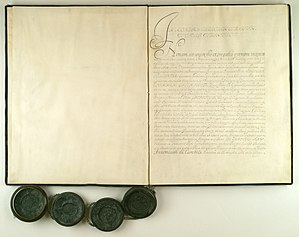Treaty of Oliva
This article includes a list of general references, but it lacks sufficient corresponding inline citations. (April 2011) |
 Treaty of Oliwa, first page of the document | |
| Type | Peace treaty |
|---|---|
| Drafted | 1659–1660 |
| Signed | 23 April (O.S.)/3 May (N.S.) 1660 |
| Location | Oliva, Poland |
| Parties | |
The Treaty or Peace of Oliva of 23 April (OS)/3 May (NS) 1660[1] (Polish: Pokój Oliwski, Swedish: Freden i Oliva, German: Vertrag von Oliva) was one of the peace treaties ending the Second Northern War (1655–1660).[2] The Treaty of Oliva, the Treaty of Copenhagen in the same year, and the Treaty of Cardis in the following year marked the high point of the Swedish Empire.[3][4]
At
The signatories were the Habsburg Holy Roman Emperor Leopold I, Elector Frederick William I of Brandenburg and King John II Casimir Vasa of Poland. Magnus Gabriel De la Gardie, the head of the Swedish delegation and the minor regency, signed on behalf of his nephew, King Charles XI of Sweden, who was still a minor.[7]
Negotiations

During the Second Northern War, Poland–Lithuania and Sweden had been engaged in a ravaging war since 1655 and both wanted peace, in order to attend to their remaining enemies, Tsardom of Muscovy and Denmark respectively. In addition, the politically ambitious Polish queen Marie Louise Gonzaga, who had great influence over both the King of Poland and Sejm of the Polish–Lithuanian Commonwealth, wanted a peace with Sweden because she wanted a son of her close relative, the French Louis, Grand Condé, to be elected as successor to the Polish throne.[8] This could only be achieved with the consent of the Kingdom of France and its ally Sweden.[9]
On the other hand, the Danish and Dutch envoys, as well as those of the
France, in practice governed by Cardinal Mazarin, wanted a continued Swedish presence in Germany to counterbalance Austria and Spain, which were France's traditional enemies. France also feared that a continued war would increase Austria's influence in Germany and Poland–Lithuania. The Austrian and Brandenburgian intrusion into Swedish Pomerania was considered a breach of the Peace of Westphalia, which France was under the obligation to prosecute. France therefore threatened to contribute an army of 30,000 soldiers to the Swedish cause unless a treaty between Sweden and Brandenburg was concluded before February 1660.
Negotiations had begun in Toruń (Thorn) in autumn of 1659. The Polish delegation later moved to Gdańsk, and the Swedish delegation made the Baltic town of Sopot (Zoppot) its base.
When news of the death of King

Terms
The treaty had John II Casimir renounce his claims to the Swedish crown, which his father Sigismund III Vasa had lost in 1599. Poland–Lithuania also formally ceded to Sweden Livonia and the city of Riga, which had been under Swedish control since the 1620s. The treaty settled conflicts between Sweden and Poland–Lithuania left standing since the War against Sigismund (1598–1599), the Polish–Swedish War (1600–1629) and the Northern Wars (1655–1660).
Brandenburg's House of Hohenzollern was also confirmed as independent and sovereign in the Duchy of Prussia. It had previously held the territory as a fief of the Polish-Lithuanian Commonwealth. If the Hohenzollern dynasty became extinct in the male line in Prussia, the territory was to revert to the Commonwealth.
The treaty was achieved by Brandenburg's diplomat, Christoph Caspar von Blumenthal, on the first diplomatic mission of his career.
See also
- Swedish Livonia
- Polish Livonia
- List of Swedish wars
- List of treaties
Sources
References
- ^ a b Evans (2008), p. 55
- ^ a b c d Frost (2000), p. 183
- ^ "Freden i København, 27. maj 1660". danmarkshistorien.dk. Retrieved June 1, 2019.
- ^ Nina Ringbom. "Freden i Kardis 1661". Historiesajten. Retrieved June 1, 2019.
- ^ "Friede von Oliva". Monarchieliga. Retrieved June 1, 2019.
- ^ Nina Ringbom. "Freden i Oliva 1660". Historiesajten. Retrieved June 1, 2019.
- ^ Bély (2000), p. 511
- ^ a b Starbäck (1885/86), p. 363
- ^ Georges Mongrédien. "Louis II de Bourbon, prince de Condé". britannica.com. Retrieved June 1, 2019.
- ^ Stephan Skalweit. "Frederick William, elector of Brandenburg". britannica.com. Retrieved June 1, 2019.
- ^ "Oliwa Cathedral". whattodoingdansk.com/. Retrieved June 1, 2019.
Bibliography
- Bély, Lucien; Isabelle Richefort (2000). Lucien Bély (ed.). L'Europe des traités de Westphalie: esprit de la diplomatie et diplomatie de l'esprit. Presses universitaires de France. ISBN 2-13-049964-3.
- Evans, Malcolm (2008). Religious Liberty and International Law in Europe. Cambridge Studies in International and Comparative Law. Vol. 6. Cambridge University Press. ISBN 978-0-521-04761-6.
- Frost, Robert I. (2000). The Northern Wars. War, State and Society in Northeastern Europe 1558–1721. Longman. ISBN 978-0-582-06429-4.
- Starbäck, Carl Georg; Bäckström, Per Olof (1885–1886). Berättelser ur svenska historien. Vol. 6. (Stockholm: F. & G. Beijers Förlag)
